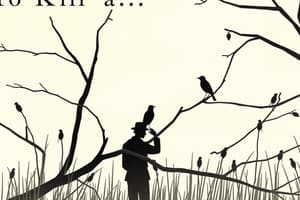Podcast
Questions and Answers
Who is the narrator of 'To Kill a Mockingbird'?
Who is the narrator of 'To Kill a Mockingbird'?
- Atticus Finch
- Scout Finch (correct)
- Jem Finch
- Boo Radley
Atticus Finch is a lawyer in Maycomb.
Atticus Finch is a lawyer in Maycomb.
True (A)
Who won an Oscar for his portrayal of Atticus Finch in the film adaptation of 'To Kill a Mockingbird'?
Who won an Oscar for his portrayal of Atticus Finch in the film adaptation of 'To Kill a Mockingbird'?
Gregory Peck
Tom Robinson is a ___ man falsely accused of raping Mayella Ewell.
Tom Robinson is a ___ man falsely accused of raping Mayella Ewell.
Match the character with their description:
Match the character with their description:
Flashcards are hidden until you start studying
Study Notes
To Kill a Mockingbird Novel
- Published in 1960 by Harper Lee
- Explores themes of racism and social injustice
Characters
- Jean Louise "Scout" Finch
- Narrator of the story
- 6 years old at the beginning of the story
- Tomboy, eager, inquisitive, and observant
- Jeremy "Jem" Finch
- Scout's older brother, 10 years old at the beginning of the story
- Respectful, considerate, and possesses a capacity for deep thinking
- Atticus Finch
- Lawyer in Maycomb, Alabama
- Widowed father of Jem and Scout
- Well-respected, honest, open-hearted, and fair-minded
- Calpurnia
- Finch family cook
- Provides insight into the African-American community
- Acts as a bridge between the Finch children and the broader racial issues in their society
- Arthur "Boo" Radley
- Reclusive neighbor who becomes the subject of town legends
- Fascinates Jem, Scout, and Dill during their summers
- Charles Baker "Dill" Harris
- 6-year-old nephew of Rachel Haverford
- Close friend to Jem and Scout
- Bob Ewell
- Father of Mayella Ewell, who falsely accuses Tom Robinson of raping her
- Jobless, racist, and spends his welfare checks on alcohol
- Tom Robinson
- Black man accused of raping Mayella Ewell
- Defended by Atticus Finch, kind, honest, and hardworking
- Unjustly convicted and dies in a prison escape attempt
Plot Summary
- Story is recounted by an adult Jean Louise Finch, looking back on her childhood in Maycomb, Alabama
- Starts in 1933, when Scout is 6 years old
- Atticus agrees to defend Tom Robinson, a Black man falsely accused of raping Mayella Ewell
- Trial exposes Maycomb's deep-seated racism
- Tom is found guilty, despite knowing the real culprit is Bob Ewell
- Bob Ewell publicly threatens Atticus, who is working on an appeal for Tom
- Tragically, Tom is shot and killed while attempting to escape from prison
Symbols
- The Mockingbird
- Symbolizes innocence and vulnerability
- Tom Robinson and Boo Radley lose their innocence throughout the novel
- Physical Challenges
- Many characters face physical or mental challenges, symbolizing human vulnerability
- Tom Robinson has a mangled left arm, Jem's arm is broken by Bob Ewell, Boo Radley has a damaged spirit, and Atticus has poor eyesight
- The Knothole
- Symbolizes friendship and communication
- Boo Radley uses the knothole to leave gifts for Jem and Scout, establishing a connection without exposing himself to vulnerability
- The Rabid Dog
- Symbolizes the pervasive and dangerous disease of racism in the town
- Sheriff Tate's refusal to shoot the dog mirrors his refusal to serve justice for Tom Robinson before the trial
Themes
- Race and Prejudice
- Central to the novel, highlighting the institutional racism of the Jim Crow South
- Exposes the deep-seated racial tensions in Maycomb
- Class
- Class divisions are evident throughout the novel
- Atticus rejects these divisions, while Aunt Alexandra upholds Maycomb's class distinctions
- Equality vs. Inequality
- Explored through various lenses, including race, class, and gender
- Highlights the pervasive inequalities that shape the characters' lives and interactions
- Morality
- Central theme in the novel, intertwined with issues of race and inequality
- Challenges readers to consider how individuals who see themselves as moral and Christian can also be racists
Studying That Suits You
Use AI to generate personalized quizzes and flashcards to suit your learning preferences.




